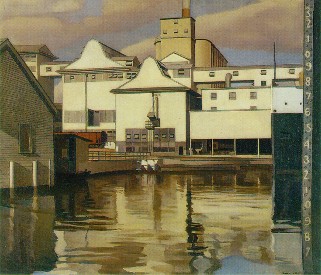Today is 4 July so this week’s appropriately all-American painting is River Rouge Plant, by Charles Sheeler, a double-edged paean to one of the behemoths of American heavy industry, the Ford Motor Company. The picture can be seen at the Whitney Museum of American Art in New York.
Sheeler’s painting discloses a carefully framed view of the first factory in America to assemble a complete motor car on site. The work was painted in 1932 but its genesis lies some five years earlier, when the artist received a commission from Vaughn Flannery, the art director of N.W. Ayer & Son, the advertising agency which had won the Ford contract in 1927. At the time, Sheeler was combining his career as a painter with work as a commercial photographer, taking fashion photographs and pictures of celebrities for Conde Nast, as well as a series of coolly beautiful photographs of modern architecture and design for his various clients in advertising. Flannery approached him to take a series of photographs of the River Rouge Plant for Ford to use in its publicity. Sheeler welcomed the commission. The new buildings and machines spawned by heavy industry struck him as the most distinctive expression of American life in the 1920s and 1930s. “Every age manifests the nature of its content by some external form of evidence,” he wrote. “In a period such as ours, when only a few isolated individuals give evidence of religious content, some form other than that of the Gothic cathedral must be found for our authentic expression. Since industry predominately concerns the greatest numbers, finding an expression for it concerns the artist.”
In late 1927 the artist travelled to the Ford Company’s manufacturing base south-west of Dearborn, Michigan, ten miles from Detroit and close to the Rouge River, which...


